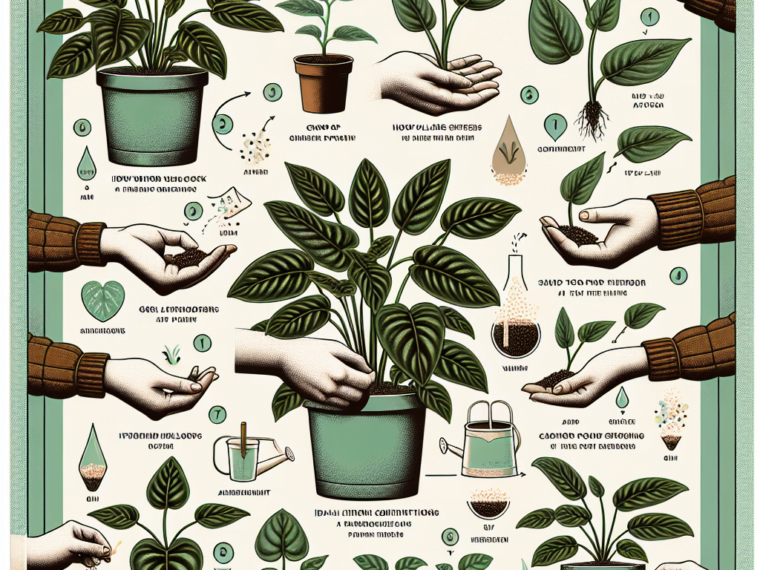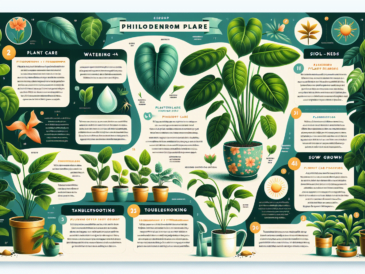Philodendron plants are a diverse group belonging to a large genus known for their adaptable and easy-going nature. These lush foliage beauties claim tropical origins and are part of the Araceae family. Their incredible resilience makes them particularly well-suited for indoor life, thriving under conditions that might challenge less hardy species.
Overview of the Philodendron Genus
The Philodendron genus comprises an extensive array of plant species, each boasting unique characteristics yet sharing certain familial traits. The spectrum ranges from large, leafy shrubs to vines that love to climb or trail, depending on their inherent growth habits. Their ability to purify the air adds another layer of benefit when they are brought into the home environment.
Popularity and Appeal as Houseplants
Due in part to their low-maintenance requirements, Philodendrons have secured a fond place in the hearts of plant enthusiasts around the globe. The plants’ versatility in adapting to various light conditions combined with their forgiving nature when it comes to occasional watering mishaps contributes to their widespread appeal. And let’s not forget, their attractive leaves—often exuberant in size or dynamic in patterning—are surefire decor enhancements.
Varieties Commonly Kept Indoors
Many Philodendron varieties have found fame as favored houseplants. Some of the stars include the ‘Heartleaf’ Philodendron with its charming, heart-shaped leaves, the stately ‘Tree Philodendron’ known for its robust size, and the striking ‘Brasil’ variety, which flaunts vibrant green and yellow variegated foliage. Each of these has been embraced for both their decorative potential and their easy-care profiles.
Light Requirements
Philodendrons are not particularly picky when it comes to light. They’ll thrive in a range of conditions from low to bright, indirect light. However, these versatile plants are best off without direct sunlight, which can scorch their leaves. To keep your Philodendron happy, place it in a spot where it can bathe in soft light throughout the day. East or north-facing windows are usually safe bets for creating this ideal light environment.
Watering Practices
Maintaining a regular watering schedule is key to Philodendron care. These plants enjoy moist soil but don’t take kindly to being waterlogged. The perfect balance involves letting the top inch of soil dry out between waterings. This method prevents overwatering and root rot, which is often the demise of many houseplants. It’s wise to feel the soil with your fingers; if it feels dry at that depth, it’s time to water again. Also, be mindful of seasonal changes; your Philodendron will likely need more water during the growing season and less during winter months.
Soil and Repotting
The soil supporting your Philodendron should be rich and well-draining — a peat-based mix is generally a solid choice. When repotting, which you’ll find necessary every few years as your plant grows, select a pot only slightly larger than the previous one; going too big too soon can lead to excess moisture buildup in the soil. Aim to repot in spring or early summer, which gives the Philodendron a chance to establish itself during its active growth period. When handling the roots, be gentle to avoid stress and damage which could impede the plant’s development.
Temperature and Humidity
Philodendrons thrive in an environment that mimics their native tropical habitat. This includes a cozy temperature range between 60-80 degrees Fahrenheit (15-27 degrees Celsius). It’s crucial to keep these plants away from cold drafts and drastic temperature swings, which can shock them. Humidity is just as important; aim for a humidity level of around 40-60%. If your home’s air is too dry, consider using a humidifier or placing a water tray near your plant to boost moisture levels.
Fertilization
To support healthy growth, philodendrons require regular fertilization, but don’t go overboard! Feeding them every six to eight weeks during the growing season (spring and summer) with a balanced, water-soluble fertilizer will do the trick. In fall and winter, reduce the frequency because the plants enter a dormant stage and need less nourishment. Remember, less is more—over-fertilizing can harm your philodendron, causing root burn and other issues.
When and How to Prune Philodendrons
Pruning your Philodendron is best done in spring or fall, just before or at the start of their growth spurt. Use clean, sharp scissors or pruning shears to ensure healthy cuts. Pinch off any yellow or brown leaves that clearly show signs of dying. It’s also a good idea to remove any leggy stems to foster a fuller appearance. Cut just above a leaf node; new growth will develop from this point. If there are any aerial roots, you can guide them towards the soil or trim them if they’re excessive, being careful not to stress the plant.
Cleaning Leaves and Maintaining Plant Health
Philodendron leaves accumulate dust like any other indoor plant. Dust can block sunlight and reduce photosynthesis, so it’s beneficial to wipe leaves with a damp cloth every now and then. While doing so, inspect for pests and diseases—healthy, clean foliage is less prone to issues. Occasionally showering the plant with lukewarm water can cleanse and hydrate the leaves effectively, but let them dry to prevent fungal infections.
Managing Growth and Shaping the Plant
To control your Philodendron’s size and shape, redirect growth by trimming it back. When you prune longer vines, you can encourage branching which leads to a bushier look. This process allows you to customize the plant’s appearance according to your preference. Keep in mind, though, that it’s normal for the lower leaves to shed as the plant grows; don’t be alarmed unless it looks excessive. Stake tall Philodendrons to support them, or use a trellis or moss pole for climbing varieties—this mimics their natural growing conditions by harnessing their vertical inclination.
Methods of Propagating Philodendrons
Philodendron plants can be propagated using several techniques. Among the simplest methods is stem cuttings, which involves snipping a section of stem from a healthy plant. Another way is air layering, which encourages roots to form on a living stem still attached to the mother plant. Additionally, you can separate offshoots, known as pups, from the parent philodendron to create new plants.
Step-by-Step Propagation Guide
To successfully propagate a Philodendron through stem cuttings, you’ll first need to select a healthy stem that has at least two or three leaves attached. Ensure the cutting tool is clean to prevent disease transmission. Make the cut just below a leaf node, as this is where the roots will sprout. Submerging the cut end in water lets you watch the rooting progress; however, planting directly into soil is beneficial for root growth. If propagating by air layering, make an upward slit in the stem and insert a toothpick to keep it open. Wrap moist sphagnum moss around the incision and secure it with plastic wrap to maintain moisture levels until roots develop. To separate pups from their mother plant, gently untangle the roots and remove the pup, making sure it has its own root system before potting it separately.
Tips for Successful Rooting and Growth
For exceptional rooting success, remember these pointers: Use fresh, filtered water if choosing water propagation, changing it every few days to fend off bacteria. Placing cuttings in indirect light rather than direct sunlight prevents them from burning out before they flourish. Stimulating root growth can be enhanced with rooting hormones but isn’t necessary.
Keep the soil consistently moist, not waterlogged, when planting in soil to endorse healthy root development. Lastly, patience is key; give your philodendron time to adapt and grow strong roots before expecting significant growth.
Identifying and Treating Pests
Confronting infestations in your philodendron plants demands immediate attention to safeguard their health. Start by spotting the culprits; keep an eye out for signs of aphids, spider mites, mealybugs, and scale insects. These pests are fond of sucking on plant sap, which impairs plant vigor and induces leaf yellowing or distortion. Combat these pests through isolation of the affected plant to halt further spread. Employ a gentle spray of water to dislodge milder infestations or opt for insecticidal soap for stubborn cases. For persistent issues, neem oil or other suitable pesticides can be used as per the product instructions.
Disease Prevention and Management
Healthy philodendrons are less likely to succumb to diseases, but preventive measures are key. Ensure proper air circulation and avoid overcrowding to reduce moisture build-up that fungi adore. Water your philodendron sparingly to prevent root rot, a common issue arising from soggy soil. If you notice dark, mushy roots or a foul smell, act swiftly by removing the diseased parts and repotting in fresh, well-draining soil. For foliar diseases like leaf spot, prune away infected foliage and consider fungicide treatments if necessary.
Environmental Stress Issues
Philodendrons can experience stress due to unfavorably environmental conditions. Temperature extremes on either end are harmful—these tropical natives prefer a cozy range between 65-80°F (18-27°C). Keep them away from drafts and fluctuating temperatures. Bright, indirect sunlight is their sweet spot; direct sun scorches leaves while too little light results in leggy growth. Brown leaf tips often signal low humidity. Strive for a humid environment or use a pebble tray or humidifier to up the moisture around your cherished greens.
Remember not to overdo it with watering or fertilization—less is sometimes more. A balanced fertilizer used every few months during the growing season suffices. Give your philodendron the optimal care it craves and watch it flourish splendidly!
Philodendrons are a diverse group of plants, and each species may require tailor-made care to thrive. Let’s delve into some mesmerizing details regarding the care of different philodendron varieties.
Unique Care for Climbing vs. Non-Climbing Varieties
Understanding whether your philodendron is a climber or non-climber can greatly impact how you care for it. Climbing philodendrons, such as the heartleaf philodendron (Philodendron hederaceum), adore support like a moss pole or trellis to latch onto. This mimics their natural habitat, where they would scale trees and larger plants. They also prefer higher humidity levels to emulate tropical environments.
Contrastingly, non-climbing species, also known as self-heading philodendrons like the Philodendron bipinnatifidum, don’t need vertical support. Instead, they grow large and bushy and can become quite the statement piece in your home or garden. Their water requirements might be less rigorous, but they still yearn for consistent moisture and well-draining soil.
Species-Specific Tips and Tricks
Different philodendron species come with their own set of preferences. For instance, the velvety-leaved Philodendron gloriosum thrives with indirect light and a bit more attention to soil moisture. Overwatering is a faux pas for this beauty, as soggy soil can lead to root rot – an absolute nightmare for plant enthusiasts.
Another popular variety, the Philodendron xanadu, requires slightly drier conditions between watering sessions and lots of space to spread out its elegant, lobed leaves. Overcrowding should be avoided to reduce the risk of disease and pest invasion.
Highlighting Popular Species and Their Individual Needs
Let’s zoom in on a few popular species:
- Heartleaf Philodendron (Philodendron hederaceum): Cherishes humid conditions and consistent watering, but let the top inch of soil dry out before splashing again.
- Fiddleleaf Philodendron (Philodendron bipennifolium): Enjoys bright, indirect light and occasional pruning to maintain an ideal form without getting too leggy.
- Split-Leaf Philodendron (Philodendron selloum): It grows vast and loves rich, loose soil that promotes excellent drainage. This giant prefers indirect sunlight and shoudln’t be left in standing water.
Maintaining these lush green beauties isn’t overly complicated when you align their care with their natural habits. However, one shouldn’t dismiss the importance of understanding each plant’s unique needs– neglecting this can make the difference between a thriving philodendron forest in your living area and a sad sight of wilted leaves. Lastly, pests like mealybugs and spider mites just love making a meal out of stressed philodendrons; thus, keeping your greens happy is a surefire way to keep those pesky critters at bay.


